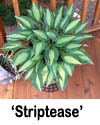|
 |
 Hostas are easy
to grow and require minimal care. That about sums it up,
I guess. However, as with most things, it really is not
all that simple. Hostas are easy
to grow and require minimal care. That about sums it up,
I guess. However, as with most things, it really is not
all that simple.
True, on average, the
genus, Hosta,
does require less care than many other
herbaceous
perennials grown in our landscapes. They can take a lot
of abuse but will prosper if you follow just a few
cultural hints.
|
 |
Somewhere along the line,
hostas got the misnomer as a "shade-loving" perennial.
Anyone who knows a little about plant science
understands that all green plants must have a certain
level of light in order to carry out
photosynthesis. If
you put one of these plants in the total dark, they must
die.
 Therefore, it is better
to call plants like hostas, shade tolerant plants. This
gives us a lot more latitude in finding the ideal place
for them to grow in our landscape. Therefore, it is better
to call plants like hostas, shade tolerant plants. This
gives us a lot more latitude in finding the ideal place
for them to grow in our landscape.
Many hostas will thrive
and multiply rapidly in full sun, IF they are given
enough moisture. If the soil is NOT well endowed with
organic matter or is sandy, the hosta leaves will
usually scorch in full sun. However, put plenty of
compost, leaf mold or other organic material in the soil
and water them regularly and they will thrive.
Another factor in the
amount of light a hosta needs or can tolerate depends on
the color of the leaves.

|
 |
Hostas are pretty
flexible when it comes to soil types. However, since
they need a steady availability of moisture, it is
important that the soils be well-drained but also
moisture retentive.
This sounds almost
counter intuitive but it is true of many plants that,
when they need the moisture, it had better be there for
them. But, they will not tolerate sitting in water
logged soils or they may become plagued with rot
diseases.
 Soils dominated by
clay
usually become poorly drained and have low oxygen levels
for good root growth. Those with high
sand content drain
too well and become droughty and do not hold nutrients
well. Soils dominated by
clay
usually become poorly drained and have low oxygen levels
for good root growth. Those with high
sand content drain
too well and become droughty and do not hold nutrients
well.
Fortunately, both of
these conditions can be remedied by the addition of
large amounts of organic matter such as compost, leaf
mold or other soil conditioners. The organic matter
loosens the clay and allows more pore space for water
and air. In the sand, the organic matter "clogs" the
huge pores and holds moisture and nutrients better.
In terms of soil acidity
i.e.
pH, hostas, like many, many other landscape plants
prefer a slightly acid soil in the pH range of 6.0 to
6.5. Here again, they are very flexible and will
tolerate a much wider range. Don't guess about the soils
pH. Get a soil test done at a quality laboratory such as
the one at your local
Extension
Service Office.
Never add lime to the soil unless instructed to do so by
a soil test!

|
 |
 Hostas were traditionally
considered an "ironcast" plant that had no serious
problems in the landscape. Well, as with a lot of things
in life, as we gain experience over time, we tend to
find more problems. This is true with hostas but, they
are still pretty pest resistant...or resilient. Hostas were traditionally
considered an "ironcast" plant that had no serious
problems in the landscape. Well, as with a lot of things
in life, as we gain experience over time, we tend to
find more problems. This is true with hostas but, they
are still pretty pest resistant...or resilient.
The major pests of hostas
appear to be:
-
Slugs - These
shell-less snails wreak havic with hosta leaves in
many gardens. They are difficult to control because
they like the same environmental conditions that
foster good hosta growth. However, there is some
hope. For more...
-
Deer - In the
latter half of the 20th century, more and more of us
moved out into deer territory to build our houses.
These cute critters soon learned that they had a
taste for the Asian import called the hosta. More on
deer....
-
Foliar Nematodes -
Not only are hostas bothered by creepy crawly slugs
and large four legged deer but they are now being
invaded by microscopic (or nearly so) roundworms
called nematodes.
More...
-
Virus - Although
some plant viruses result in interesting, artistic
looking variegation in plants, they also often cause
a loss of plant vigor and are impossible to get rid
of once they get into the plant. More about
virus in hostas...
-
Southern Blight -
This
fungal disease
causes root rot primarily in southern parts of the
United States.
Other problems
occasionally encountered in hosta gardens include:

|
 |
 In a hosta "collectors"
garden, the species stands alone for display. However
for most gardeners, hostas are just one of many types of
plants used in the landscape. Various types of plants
and hardscape features work well to complete hostas in
the garden including: In a hosta "collectors"
garden, the species stands alone for display. However
for most gardeners, hostas are just one of many types of
plants used in the landscape. Various types of plants
and hardscape features work well to complete hostas in
the garden including:
|
 |
 Just
like most herbaceous perennials, hostas may be
propagated in several ways. Enthusiasts, hobbyists
and professionals multiply the number and types of
hostas all the time. Just
like most herbaceous perennials, hostas may be
propagated in several ways. Enthusiasts, hobbyists
and professionals multiply the number and types of
hostas all the time.


|
|



